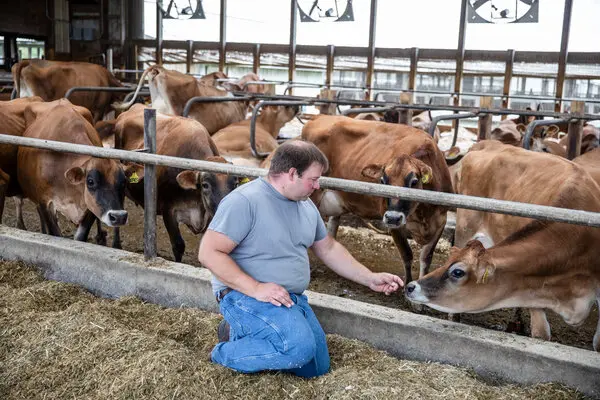Introduction: The Scale of U.S. Dairy Farming
The United States is home to some of the largest and most advanced dairy farms in the world, producing millions of gallons of milk each year. Dairy farming is not only a vital part of the U.S. agricultural landscape but also a cornerstone of its economy. From small family-owned farms to large-scale operations, the dairy industry contributes significantly to both rural development and the overall food supply chain. Among the giants in this industry stands one farm that outshines the rest in terms of size, technological advancement, and sustainable practices—Fair Oaks Farms.
Understanding the U.S. Dairy Industry
Before exploring the largest dairy farm in the U.S., it’s essential to understand the scope and scale of the nation’s dairy industry. The U.S. is the second-largest producer of cow’s milk globally, producing approximately 223.2 billion pounds of milk in 2023 alone. Dairy farms across the U.S. house over 9.4 million cows, with major dairy-producing states like California, Wisconsin, and Idaho leading the charge. These states contribute nearly 50% of the total milk production in the country.
The U.S. dairy industry has evolved over the decades, moving from small-scale farms to highly mechanized and large-scale operations. Today’s dairy farms must balance efficiency with sustainability, using advanced technology to optimize milk production while caring for their herds and reducing environmental impact.
Largest Dairy Farm in the U.S.: Fair Oaks Farms
Fair Oaks Farms, located in Fair Oaks, Indiana, is widely recognized as the largest dairy farm in the U.S., setting standards for size, technology, and sustainability. Spanning over 19,000 acres, Fair Oaks Farms is home to over 36,000 dairy cows, which together produce more than 260,000 gallons of milk each day.
The farm was founded in 1999 by a group of farmers with the goal of creating a large-scale, sustainable dairy operation that could also educate the public about modern dairy farming. Fair Oaks Farms has since grown into an agricultural tourism destination, where visitors can experience the entire dairy production process firsthand, from cow milking to cheese-making.
Innovations in Dairy Farming at Fair Oaks
Fair Oaks Farms is not just a dairy farm; it’s a hub for technological innovations and sustainable farming practices. The farm uses cutting-edge technology to manage daily operations, ensuring efficiency and care in everything they do. One of the key innovations at Fair Oaks Farms is their use of robotic milking systems, which allow cows to be milked more comfortably and efficiently. These robots can milk up to 60 cows per hour, reducing labor needs and improving the health and comfort of the cows.
In addition to robotic milking, Fair Oaks Farms is a leader in sustainable farming practices. The farm has implemented a closed-loop system for manure management, turning waste into renewable energy through anaerobic digesters. These digesters convert manure into biogas, which is then used to power farm operations. In fact, Fair Oaks Farms generates enough biogas to offset nearly 2 million gallons of diesel fuel annually, significantly reducing its carbon footprint.
Moreover, Fair Oaks Farms recycles 100% of its water, using a combination of filtration and purification systems to ensure that all water used on the farm is reused sustainably. This commitment to eco-friendly practices makes Fair Oaks Farms a model for other large-scale dairy farms across the country.
Life on the Largest Dairy Farm in the U.S.
A day on Fair Oaks Farms is a well-orchestrated effort, where precision and care define daily operations. The farm operates 24/7, with staff and technology working together to ensure that each cow is milked, fed, and cared for. On average, each cow at Fair Oaks Farms produces around 7.5 gallons of milk per day, contributing to the farm’s immense output.
Animal welfare is a top priority at Fair Oaks Farms. The farm’s cows are housed in climate-controlled barns, designed to keep the cows comfortable regardless of the weather. The barns are equipped with soft bedding, and the cows are allowed to roam freely, reducing stress and promoting overall health.
Fair Oaks also practices ethical farming, ensuring that cows are treated humanely throughout their lives. They work closely with veterinarians and animal welfare experts to maintain high standards of care, which in turn helps increase milk production and quality.
Challenges Faced by Large-Scale Dairy Farms
Even the largest dairy farms face challenges, from environmental concerns to fluctuating milk prices. One of the biggest challenges for farms like Fair Oaks is managing the environmental impact of such large-scale operations. Despite their efforts to use sustainable practices, large farms still generate significant amounts of manure and greenhouse gases. To address this, Fair Oaks Farms has invested in manure-to-energy technology and other eco-friendly solutions to reduce their overall environmental footprint.
Another major challenge is the volatility of milk prices. The price of milk is influenced by global demand, feed costs, and other economic factors, making it difficult for dairy farmers to predict future revenues. In 2023, for example, U.S. milk prices fluctuated between $18 to $25 per hundredweight, putting pressure on farms to manage costs effectively while maintaining production levels.
The Future of Dairy Farming in the U.S.
As consumer preferences shift and environmental concerns grow, the future of dairy farming in the U.S. faces both opportunities and challenges. One emerging trend is the increasing demand for plant-based milk alternatives, which has led to questions about the long-term viability of traditional dairy farms. However, many industry experts believe that dairy farming will continue to thrive, especially as farms like Fair Oaks embrace technological innovations and sustainable practices.
In addition, the dairy industry is seeing advancements in genetics, allowing farms to breed cows that produce more milk with fewer resources. As the industry evolves, large farms like Fair Oaks are likely to play a critical role in shaping the future of dairy farming by adopting new technologies and continuing their focus on sustainability.



